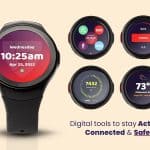
The right tablet and app can make staying connected even easier.
Seniors today are more connected to loved ones than ever before. Thanks in part to the popularity of video calls, older adults can check in with their great-grandchild while they are at college or see how much their grandchild is showing while she is pregnant. Video calls are quite helpful for connecting seniors and decreasing feelings of loneliness, but that’s not all video calls can do.
Older adults can also use video calling to stay in touch with their physicians. Many doctor offices use telehealth options with their patients, a trend that only gained more popularity during the pandemic. There’s no sign of telehealth options going away and many older adults can skip the drive to their physician’s office and instead connect over a video call. This in conjunction with a medical alert device, can help seniors age in place much longer. You can research the Life Alert cost and find out the best options for your aging loved one to stay protected at home.
There’s more good news, too. It doesn’t take a lot of technical savviness to successfully operate a video call. Most seniors can confidently learn the process and as long as they have an internet connection, they can check-in on their loved ones and friends anywhere in the world.
We’ve pulled together everything you need to consider when purchasing items or apps for your loved one in order to start – or upgrade – their video calling capabilities.
Best Tablets for Seniors of 2022
Tablets have come a long way over the past decade, with today’s tablets offering the user the capability to watch movies and other videos just as clearly as if they were watching on television. However, there are also many more tablets on the market than there were only a decade ago, which can make choosing one a bit more time-consuming.
Here are a few of the top-rated tablets that are worth the investment.
Lenovo Yoga Smart Tab – This tablet is popular and for good reason. It pairs easily with a Google assistant, is large enough, and has a kickstand so that you don’t have to hold it when using it.
Samsung Galaxy Tab A7 – This tablet is lightweight and easy to move around from place to place. In addition, it features excellent camera lenses, so you’ll always look your best when chatting with your friends or family.
Apple 10.2 inch iPad – Apple is always on the forefront of technology, and the original iPad was one of the first tablets available. They’ve made many upgrades since that first version, of course, and this one makes changing font-size easy and is compatible with hearing aids.
How to Choose a Tablet for Seniors
There are many tablets available on the market, which can make picking the best one feel overwhelming. However, if you take time to answer a few questions before you head to the store, you can narrow down your choices to ensure you are choosing the best one for your loved one.

Keep your loved one’s needs – not your own – in mind as you search for a tablet.
What will my loved one use this tablet for?
You don’t need a tablet with tons of bells and whistles if your loved one will never use them. Jot down what you believe your loved one will use their tablet for and if possible, get their input too. Remember, while they might take advantage of a few new features, they really only need a tablet that meets their needs and nothing else.
How tech-savvy is my loved one?
Similarly, consider how tech-savvy your loved one is. For example, grabbing a tablet that will work with other smart home features is a great idea if your loved one already uses and is proficient in those smart home features. Otherwise, that capability is not needed.
How are their eyesight and hearing?
Video calls require the senior to be able to see their loved one well and hear them. If your loved one lives with hearing or vision challenges, look for a tablet that can meet those challenges. For example, find a tablet that allows for wide screen viewing or changing the font size, or that can be hooked up to wireless speakers in the home for a better experience.
Do they use a tablet now?
If your loved one already uses a tablet for their video calls and other tasks, talk to them about what they like about that tablet and what they don’t. Ask them what they use the most on the tablet and what frustrates them about the experience. If your loved one doesn’t currently use a tablet or smartphone for their video calls, consider getting a no-frills and easy-to-use tablet for their first.
Standard Tablet Features
When considering which tablet to choose for your older loved one, be sure the tablet has features that will suit their abilities and preferences. For example, make sure the screen size is large enough for them to comfortably use but isn’t so large that it makes it difficult to carry around the house. Here are a few other features to consider when making your decision.
Battery life
No one wants to charge their tablet every day and an uncharged tablet is often an unused tablet. Look for an option that has a long battery life and a short charge time.
Warranties and Guarantees
Protect your investment by ensuring your loved one has a tablet that is covered by warranties or guarantees. Look for a warranty that will cover any accidental damage, which is common in any household.
Voice Assistant
If your loved one is familiar with a virtual home assistant, like a Google Home or Amazon Alexa, having a voice assistant on their tablet can come in handy. You’ll want to see if the tablet has its own assistant feature or if it can integrate with your loved one’s current virtual assistant.
Volume Control and Font Size
Finally, look for a tablet that makes adjusting font size and volume easy. When a senior can see and hear what they are doing on their tablet, they are more likely to continue to use it.
How to Set Up a Tablet for Seniors
Now that you have picked a tablet that will suit the needs of your older loved one, it is time to get it ready to use. Resist the urge to set up everything on your own and then just present it to your loved one. Instead, involve them in the set up process so they can become familiar with the device and feel more confident while using it. Be sure you integrate it to any current operating systems they already use in or on their smartphone, and upload any apps they will use. Remember to keep frequently used apps on a specific screen so that it is not overwhelming when they are searching for it.
How Much Do Tablets Cost?
Tablets can range from $150-$1,200, depending on the features available. You can find one within your budget that still has the features your loved one will use. Remember, don’t pay for a tablet that is too advanced for your loved one. Pick one they will feel confident using and be successful at.
Video Call Devices
If your loved one isn’t interested in any extra features that a tablet can offer and instead only wants a device that allows them to video call their favorite people, consider trying alternative devices. Here are a few that you can research and consider.
ViewClix
The ViewClix is a smart frame used for video calling loved ones. It looks like a photo frame and any call is easily answered with the click of a button. The device comes in two sizes and caregivers are able to manage the device and accounts remotely.
Amazon Echo Show
Amazon upgraded its virtual assistant game by introducing the Echo Show, a screened device that integrates with any other Amazon devices in the home. You can use the Amazon Show to initiate and answer video calls, and you can pair it with the Alexa Together program.
GrandPad
The GrandPad is a tablet specifically designed for seniors, making it even easier to connect with family members with a video call. It’s a snap to use and comes with a stylus, which can be handy for those who prefer it.
Video Call Apps
Having the right app to make your video calls on is the final step of the process of connecting with your older loved one. Here are a few of the most common video call apps so that you can choose one that your entire family will use to communicate with one another.
Zoom
Zoom is one of the most popular video call platforms, especially when many companies increased their usage of the app during the pandemic. Zoom requires the organizer to invite others to their meeting room, so it might be helpful if other members of the family organize meetings and your loved one is simply invited. This way, they just need to click a link in order to connect. Zoom also has the option of sending a calendar invite which can be helpful for seniors who might forget.
Zoom is free for most users, though you can pay for an account that allows you to have more people in your meeting room.
Skype
Skype is another video call app that is less used for work purposes and more used for socialization. This app might be the easiest to use and the most intuitive, making it the preferred choice of many older adults.
Google Hangouts
For those families that are avid Google users, Hangouts is the perfect place to catch up through a video call. Everyone just needs a Gmail email account and a Google account to get started, and it’s free.
Wrapping It Up
Staying connected via video calls can be the perfect way to visually check-in on your loved one. Help them to feel connected to their family, no matter how far apart you all may be. The right tablet and tools can set you up for a successful video call tradition. Good luck!


